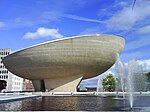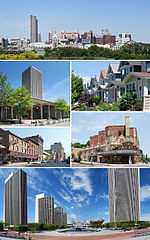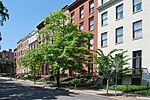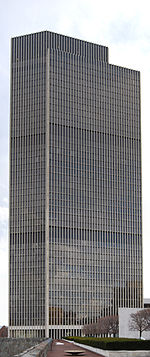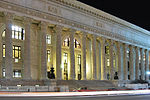New York State Fallen Firefighters Memorial
The New York State Fallen Firefighters Memorial in Albany, New York is dedicated to the New York firefighters who have died in the line of duty. Governor of New York George Pataki officially dedicated the memorial on October 5, 1998. It features a 54-foot (16 m) by 15-foot (4.6 m) gray granite wall, with 2,312 names permanently etched into the stone. In front of the wall stands a 10-foot (3.0 m) high dark bronze sculpture of two firefighters rescuing an injured colleague created by New York sculptor Robert Eccleston. The sculpture rests on a paved plaza with charcoal and red bricks forming a Maltese Cross. The Memorial stands on the northeast side of the Empire State Plaza in the park-like area bordered by Norway maples. It is easily accessible to the hundreds of thousand of visitors who travel to the New York State Capitol and Plaza each year. The Fallen Firefighters Memorial Ceremony is held each year during national Fire Prevention Week.
Excerpt from the Wikipedia article New York State Fallen Firefighters Memorial (License: CC BY-SA 3.0, Authors).New York State Fallen Firefighters Memorial
Eagle Street, City of Albany
Geographical coordinates (GPS) Address Nearby Places Show on map
Geographical coordinates (GPS)
| Latitude | Longitude |
|---|---|
| N 42.65096 ° | E -73.75786 ° |
Address
Empire State Plaza (Governor Nelson A. Rockefeller Empire State Plaza)
Eagle Street
12234 City of Albany
New York, United States
Open on Google Maps
